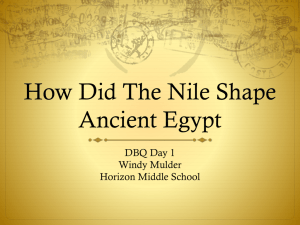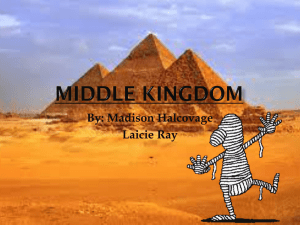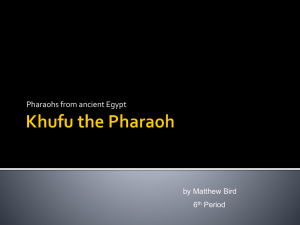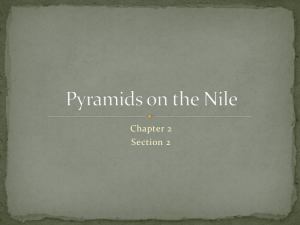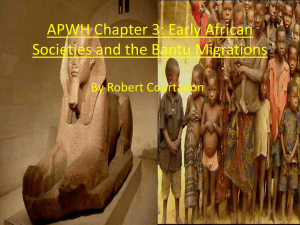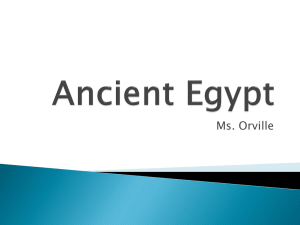File
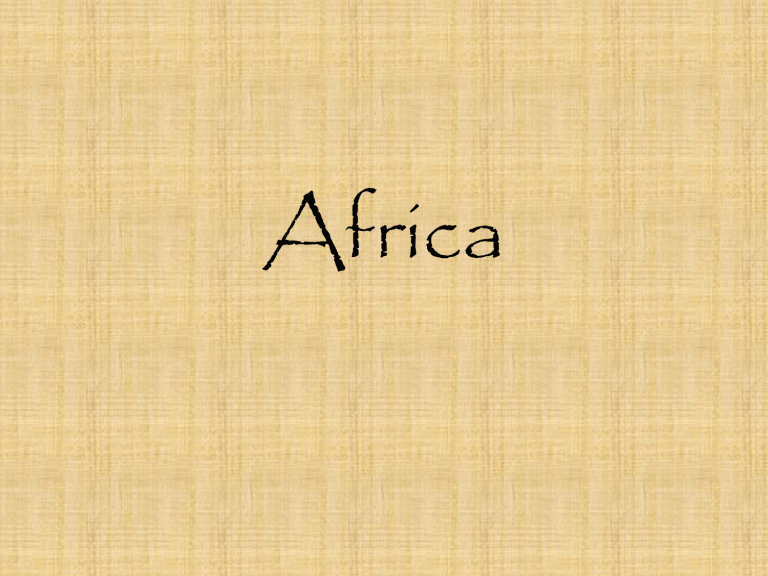
Africa
Physical Features
• Nile River
– (North East Africa)
• Niger River
– North West Africa
Physical Geography Features
• Deserts-
– dry, arid land with little to no water or vegetation(plants growing)
• Grasslands (called Savannas)
– Semi-arid land outside of a desert region.
– Seasonal rains
– Low vegetation
– Lots of animals
• Tropical Rainforests
– Heavy and consistent rainfall
– Hot & humid climate
– Abundance of vegetation & tall trees
– Animals
Physical
Features
• 2 Major Lakes
– Victoria
– Chad
African Civilizations
Egyptian
• Agriculture began around 5450 (BCE) in the area.
– People changed from
hunter-gathers to farmers
– Egyptians came to
depend on the Nile River to grow crops and maintain livestock.
– The Nile floods each summer, bring more water for
irrigation and new fertile
soil to the river valley.
Egypt
• Other Natural
Resources:
– Limestone
– Granite
• Egyptians use these stone resources to build their huge
monuments and buildings
Egypt
Temple at Karnak
Egypt
History
Egypt
• Historians split Egypt’s history into 3 main periods.
– The Old Kingdom
– The Middle Kingdom
– The New Kingdom
• The Old Kingdom
– Namer (Menes) is the first Pharaoh of a united Egypt
– First pyramids are built during this period, they are royal tombs
– 2 social classes form
• Lower: peasants and farmers
• Upper: Pharaoh, royal family, priests, scribes, and government officials
Egypt
• The Great Sphinx
Egypt
– We are still not sure who, when, or why
• It could have possibly been the Pharaoh Khafra, around 2500 BCE
Egypt
• Great
Pyramids at Giza.
Eygpt
• Old Kingdom
– Pharaohs begin to lose power towards the end of the Old Kingdom, while Nobles begin to gain power.
– Power struggles lead to decline and the First
Intermediate Period (time in between the
Kingdoms)
• The Middle Kingdom
– Golden Age of Egypt
2080BCE to 1780 BCE
– Was a time of general
prosperity and stability for
Egyptians
– This period came to an end with the Rise of the Hyksos.
• Nomads from Asia that gained power as the stability of the Middle Kingdom fell apart
• They had horse-drawn carriages and compound bows
Egypt
Egypt
• New Kingdom
– Strong Leaders from
Upper Egypt drive out the Hyksos around 1570
BCE
– A new line of Kings is established, based out of
Thebes
– Built the Egyptian
Empire
• Empire- a grouping of city-states under one
Ruler
Egypt
Rulers and Traditions
Notable Pharaohs
• Hatsheput
– 1503 BCE to 1482
BCE
– First Female
Pharaoh.
– Ruled while her son was a child
– Maintained Egyptian
Empire borders
– Often depicted as a man!
Notable Pharaohs
• Amenhotep IV
– Tries to bring Monotheism to Egypt
– Prays to the sun as the one and only god, Aton
– Changes his name to Akhenaton
– Wife is Nefertiti, son is Tutankhamun (Tut)
– This made him unpopular with the nobles and priests
– After his death, some tried to erase any signs of his existence.
Notable Pharaohs
• Tutankhamun
– The boy king. Came to the
Throne when he was 9!
– Was not a strong or very important Pharaoh.
– The discovery of his intact tomb, with treasures, in
1922, is what made King Tut famous today.
– Unfortunately Tut’s body was almost completely destroyed by Archeologists trying to get the amulets and jewels in his wrappings.
• Ramses II
– Last strong Pharaoh of Egypt
– Called Ramses the Great
– Could be the pharaoh during the exodus
– 1279 BCE to 1213 BCE (almost
70 years!!!)
Egypt
Religion
• Polytheistic
– Amon-Re (creator),
Osiris (king of the underworld), Isis
(fertility)… over 1000 gods!
• Believed all creatures had an afterlife.
• Believed that the body must be preserved to have an afterlife
– Mummification.
Egypt
• Valley of the Kings
– tombs were built for the Pharaohs and powerful nobles of the New Kingdom of Ancient Egypt.
Egypt
Valley of the Kings
• It contains some 60 tombs, starting with
Thutmose I and ending with Ramses X or XI.
Workers lived in a city called
Deir el Medina just a few miles away.
Egypt
• Architecture:
– Pyramids
– Temples
– Irrigation networks
– Sculptures and statues
Egypt
Contributions and Achievements
Egypt
• Scribes
– They were like clerks that recorded information. They were also among the only people that could read and write in the civilization
Egypt
• Writing
– Hieroglyphics
• They are pictures that represent sounds
• Egyptians had invented papyrus, a type of paper, which they used to write on.
The cartouche: These are hieroglyphics that represent someone’s name.
• We know what hieroglyphics say because of the discovery of the
Rosetta Stone.
– It contains the same story written in 3 different languages.
– This allowed archeologists to decipher hieroglyphics using a know language to compare it to.
Egypt
• Other achievements-
– First Calendar with 12 months
– Number system based on
10
– Used herbs and medicines to help the sick
– Middle class began to form
• Trade and farming were important to merchants.
African Civilizations aka
The Black Pharoahs
Kush (Nubia)
Nubia
• Located between the Red
Sea and the Nile
• Important trade routes passed through the area.
• Nubia was located in the upper region of Egypt and at one time ruled by the
Egyptian Pharaohs.
Nubia
• Nubia was the iron capital of the Ancient World
• Traded: Gold, ivory, ebony and ostrich feathers.
